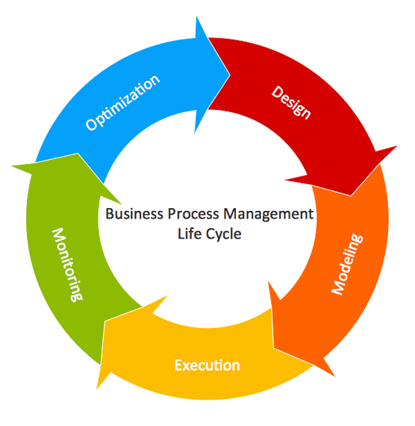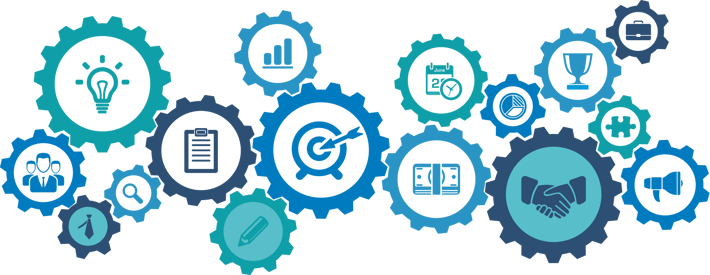What is Robotic Process Automation? Major sectors to benefit are. . .
While the technology to chat with computers has been around for many years now, bots for businesses have become a very trendy model recently. The...
8 min read
Preetisha Dayal : Mar 8, 2018 12:00:00 AM

Industries today have a cut throat competition between them, so in order to compete, one needs to be smart and work in an effective manner to be at the zenith. One of the methods followed by smart companies today is a mix of Business Process Management and Robotic Process Automation.
What is BPM and RPA and how they are effective for industries in their way of working should be known. Our industries today strive to be the best, involving not only hard work of a thousands of people but also the use of effective tools for efficient outputs and that too in no time. For fulfilling these requirements, companies use methods like BPM and RPA.

BPM or Business Process management is basically a business solution approach. It is a discipline in operations management field and a branch of Infrastructure Management that depoys various methods to analyze, optimize, discover, measure, improve, model and automate the business processes. It focuses on motivating the performance of corporate by managing their business processes.
In brief, BPM is a combination of techniques adopted by a company in order to manage its business processes. It is a systematic approach for improving organization’s workflow in an efficient and effective manner, to withstand the changing demands. A business process is a set of activities used to achieve the goal of an organization
BPM is a connection between line of business (LOB) and IT department. BPM perceives the organization’s processes as an important asset. It was developed and managed to provide value added services to the customers.
Some of the BPM tools are SIPOCs, process flows, RACIS, CTQs and histograms. Components of a BPM suite are:

The life cycle of BPM involves the following:
Design - It focuses on both the identification of existing processes of the firm and the future processes to be carried out in the firm. The areas to be focused and identified includes, the conditions of the process flow, factors involved with it, notifications and declarations. The aim is to ensure preparation of correct and efficient new designs.
Modeling - It is a theoretical design process that is, planning on paper work basis and displays a combination of variables. Example- changes in rent or material cost and to determine the process required to control different circumstances.
Execution - It involves both manual business process (human driven) and automated business process (software driven)
Monitoring - It deals with the tracking of individual processes, so that information and statistics on their performance can be provided easily and precisely. Example- to determine the problems in customer order (delivery status). It depends upon the evaluation, analysis of information of business and how it is to be monitored in real and virtual times.
Optimization - It includes regulation of the information from modeling or monitoring phase. The main objective is to identify the potentials and opportunities for cost saving or other improvements or to identify the weak spots where the problems may arise, thereby creating a business value for the firm.
Re-Engineering - When the process is too complex and inefficient to produce a desired output, then it is re-structured by the CEO or President in order to achieve a greater efficiency and greater productivity of the organization. Business process engineering has been used by organizations in order to re-engineer the entire process cycle.
The software or tools used by BPM to organize their tasks or automate processes. The softwares have converged with distant pieces such as business rules engine, business process modeling, business activity and human workflow. These systems have together given birth to Integrated Process Management Studies. BPM uses three different suites:

RPA is basically an application of technology that helps employees in a firm to arrange computer software or a “ROBOT” to store and interpret existing requirements for processing a transaction, manipulating data and communicating with other digital systems. It reduces the cost of large scale labor requirements in offices for general knowledge process work, where people are working hard, in large volumes with high transactions. RPA software can boost their capabilities and also cuts down on money and time requirements.
RPA can help in achieving a specific goaYl of an organization. It is a part of human-computer technology and provides place in financial services industry with a virtual workforce. RPA can set up and automate a platform for your front and back office and supporting functions by proving a digital platform.
It acts as a robot for industries in revolutionizing their working; administer business processes, IT support schedules, work flow schedules, infrastructure and back office work. It provides a remarkable improvement in accuracy and leads to an increase in productivity in processing of transactions, thereby improving the nature of work by displacing the people from boring and repetitive works and processes.
RPA involves three technologies:
Companies have been working on the hard copy documents basis, instead of digital systems that act as a connection between departments. Some of the disadvantages being:
Following are the benefits of using RPA in business:
List of Companies and their description that use ROBOTIC PROCESS AUTOMATION:
| COMPANY NAME |
COMPANY MANAGEMENT |
COMPANY DESCRIPTION |
| Automation Anywhere |
Mihir Shukla (CEO and Co Founder) |
Provide RPA solutions for financial services, health care, IT, BPO |
| Blue Prism |
Alaistair Bathgate (CEO) |
Provide business operations for cost effective and rapid automation of manuals |
| Daythree Business Services |
Raymond Devadass (CEO) |
The use of software robots, repetitive service processes are replaced by Automated digital workforce |
| IntelliCog technologies |
Siddhartha Singh (CEO) |
Provides RPA and AI to consulting and outsourcing companies |
| Kofax |
Reynolds C. Bish (CEO) |
Leading provider of software for business operations through unified process development |
| Kryon Systems |
Harel Tayeb (CEO) |
Deliver a common platform by RPM and AI for CRM and BPM |
| Qihan |
Ryan Wu (CMO) |
Customized applications across numerous fields like, health care, education, retail and personal use |
| Softomotive |
Marios Stavropoulous (CEO and founder) |
Offers reliable and proportional RPA technology solutions, in order to deliver operational efficiency and cost effective |
| UiPath |
Daniel Dines (CEO and co-founder) |
Provides an automation platform for global enterprises to design , deploy and manage a robotic workforce for daily operations |
Both BPM and RPA contribute in the field of business. BPM is an application or strategy to manage business processes in a better way while RPA is an application of technology used to bring revolution in businesses. Hence the combined use of RPA and BMP contribute in an efficient and systematic working of industries. Following are the points which show the use of BPM and RPA:
Hence the use of RPA or BPM or both depends upon the objective of the project to be worked on. By above information, we can clearly define the use of RPA and BPM. If automation is required then RPA should be used but BPM is efficient for fundamental transformation. It would be advantageous for the companies to use both RPA (for performance, improvement, eliminates errors and reduction in costs) and BPM (modeling). They act two sides of the same coin.
 Harel Tayeb has become the new CEO of Kyron systems (an emerging success in the field of RPA). His vision is to lead the RPA market and innovate strategies to provide a perfect product to the customers and with the help of technical expertise in services lead the new generation of intelligent automation.
Harel Tayeb has become the new CEO of Kyron systems (an emerging success in the field of RPA). His vision is to lead the RPA market and innovate strategies to provide a perfect product to the customers and with the help of technical expertise in services lead the new generation of intelligent automation.
Tayeb is seasoned in the field and has a fifteen year old experience. He is business savvy and has made remarkable innovations in the technology ecosystem, as an investor and an advisor for startups. He has held several leadership positions including AVG Israel Country manager. He founded startups in the collectibles area, Collcs Ltd., and has also managed an engineering group at Microsoft and Gteko. He believes in evolution of delivery of intelligent automation, that is, more flexibility, technology and carrying out processes in a different manner, with major changes in the field of automation. There will be a change in execution of technologies but will provide automation for greater business improvement.
He considers Kryon Systems as a strong platform for revolutions and attractive growth to pursue opportunities and execute them in long term which will accelerate strong business momentum with the use of RPA. Kyron systems is an example of success with the use of RPA and BPM for automation and fundamental theories have been catered to. It is an enterprise that relies on benefits from RPA involving labor interview operations. RPA is being used to replace traditional working conditions and provide continuous benefits in terms of efficiency and improved quality in financial, IT services, HR, supply chain, legal and customer services.
Total estimated growth of Kyron Systems- 60% CAGR to reach 4.8 billion in 2020 from 2017
-%20CEO.jpg?width=251&name=Pervinder%20Johar%20(EdgeVerve%20Limited-%20Infosys)-%20CEO.jpg)
Pervinder Johar is the chief executive officer of Edge Verve. He has been the former president and CEO of Steelwedge Software Inc. He has been a market leader in supply, planning and sales and operations planning. He took Steelwedge to remarkable heights with the position of the largest purely cloud based supply chain software company in the world. He has served as the vice president of Global Supply Chain Systems, where he has been responsible for the execution and strategy of supply chain management, product life cycle management, cash transfers business processes and IT systems for one of the largest supply chains in the world. He previously held the position of CTO at Manhattan Associates, who are leading providers of supply chains execution solutions. He has also been at senior positions in marketing technologies and finance with companies like State Street Bank and Fiedelity Investments. He has served as a CTO for two successful startup companies.
He holds a master’s degree in computer science from Villanova university, an MBA degree from Boston university and a bachelor’s degree in computer science from IIT Roorkee.
Johar aims at bringing a boom for the company in the field of RPA, thereby making revolutionary changes in the systems and processes in business outsourcing. He aims at bringing a remarkable growth in revenues of the company by using data extraction and enrichment components, providing smart user environment, advanced automation with RPA by using intelligence required by clients.
Edgeverve (Infosys) has brought 5.6% or $143 million of the company’s $ 2.5 billion revenue during the last quarter.
Are you looking for experts to help you leverage RPA for your organization? Get in touch today for a solution or POC.

While the technology to chat with computers has been around for many years now, bots for businesses have become a very trendy model recently. The...

By processing the data in motion, real-time Big Data Processing enables you to walk in parallel with the current landscape of your Business and turn...